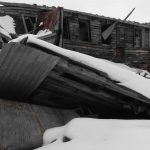As quickly as it boomed, the town of Iditarod––where many mushers are now headed––vanished. In the span of a few years, what began as a tent camp flourished into a bustling town in the gold rush, sharply died off as gold deposits diminished, and eventually faded all together with the onset of the first World War. Iditarod, once one of the most populous places in Alaska, is now a ghost town.
Although the town expanded with vigor, the overland winter trail to the town is the culmination of thousands of years of Alaskan history. It begins in bits and pieces with Native trails used for hunting, fishing, and inter-village travel. Trails are born of a necessity to get someplace, and in the 1800s, the necessity was gold. Three separate gold rushes instigated three different trails that engulfed various Native routes along the way.
First, the gold strike in Seward and the Cook-Inlet region erupted, which was followed in the late 1800s by the gold rush around Nome and the Seward Peninsula. The third gold rush was in interior Alaska between the two, and more difficult to get to. During the summer, a boat could enter the mouth of the Yukon from the west, travel upstream to the Innoko River, and then veer off into the Iditarod River. The town of Iditarod was built on the banks of that river at the terminus of navigable waters for steam barges. Although no gold was found in Iditarod itself, Iditarod was a supply port and the main hub for interior Alaska’s own version of the wild west. From there ,smaller boats and mules could travel up tributaries to surrounding mines. This route, however, only suited summertime travel, and the need for an overland trail persisted.
The most suited means of travel were sled dog teams. They offered cumulative power from many animals dispersed along the length of a dog team, versus the concentrated weight and carrying capacity of one horse or mule. Equestrians punch too deeply through the snow and sweat, whereas dog teams dance closer to the surface and perspire through their footpads and breath.
Dog teams offered an efficient solution to the challenges of ferrying important communication and critical supplies in the winter. Mail drivers became the heroes of the trail, as they risked life and limb to get the job done. Therefore, when a mail driver pulled into a roadhouse, he was given the best treatment available.
In 1910, Bob Griffiths ran the first gold train from Iditarod to Seward. Griffiths and his dog team completed the trip in thirty-seven days with approximately one quarter of a million dollars in gold in his sled. After that, he continued running the gold train until World War I––and never once was robbed.
Dog teams made a remote gold rush town like Iditarod viable year-round, which allowed entrepreneurs to find their own golden opportunities Thus, Iditarod flourished will all the businesses and accouterments of any other wild west town. Saloons, newspapers, a brothel, slaughterhouse, banks, and gold claim lawyers lined the streets. Natives could make money by selling wood to burn for electricity, steam boats, and a steam-powered Caterpillar tractor. Today, a second growth forest fills the landscape where old growth spruce stood before buildings and steam engines made their way to the banks of the Iditarod River.
At its peak in 1911, the Iditarod mining district was one of the most populous regions in the states, though historical records differ from 2,500 to 11,000 inhabitants. Part of the reason for this, is that it supported a liquid population that ebbed and flowed with seasons and economic boom. The other reason, is that not much was recorded from that time. Few historical records were kept, and the town evaporated so quickly that inhabitants scattered before their tales could be captured. The characters vanished into ghosts taking the story of the town with them. Today only a few dilapidated buildings, a concrete bank vault, and some depressions in the land where buildings once stood offer clues about this bygone bustling town.
Dick Mackey and a few others fought to save the Iditarod Trail. He saw the sprawl of the road system consuming places that were integral pieces of Alaska’s story. With the town of Iditarod abandoned, most of its viable buildings moved to the nearby town of Flat, and the role of the dog team usurped by airplanes, there was little practicality left for old overland mail routes. Overgrowth started claiming the trail back, erasing the past like a snowstorm drifts in over sled tracks. Through Mackey’s efforts, the Iditarod trail was recognized as a National Historic Trail, and is now managed by the BLM.
This race is a callback to the pioneer spirit, sled dogs, and the gold rush era. The Iditarod Trail is Alaska’s Oregon Trail, and as such, the sled dog means to Alaska what the horse meant to the Wild West. The Iditarod has preserved both, bringing them into the modern era––living history that sparks adventure for countless people.
During the race, the trail is utilized by more than just dog teams. Snowmachiners, fat-tire bikers, and hikers pulling sleds travel the trail’s expanse. All these people recreating on their public lands benefit from the efforts of Joe Redington, Dick Mackey, and the hardy mushers competing out there today.

Iditarod was abandoned so quickly, relics of the era are found inside every building, such as these banking papers.
Here in Iditarod, there are a handful of volunteers who return each year, who value that history and have become part of it. The standout figure in the group is Jim Paulus, who has donated countless man hours to fix up the checkpoint (an original gold rush building), as well as help build a cabin for the mushers (who until recent years had to sleep in tents). People like Jim, who appreciate the history of the trail, keep it alive for the rest of us to find connection with today.
Eventually planes replaced dog team mail carriers, but in a way, out here on the trail it’s all interlaced. During the race, independent pilots fly the trail from checkpoint to checkpoint, caught up in the excitement of the dogs. Out here, the race gives a space in time to reflect on the history of the landscape, individual toughness, and technological advancements that led to present-day Alaska. Airplanes replaced the role of the sled dogs, but during Iditarod, history and present-day Alaska parallel each other along the trail.
A ghost town is a relic that feeds the modern-day visitor’s imagination. It is not gone until it’s forgotten about it. Many of the stories from Iditarod may have vanished, but Iditarod race has secured the town’s place in history. The race reignites some of the pioneer spirit that would otherwise extinguish as quickly as the gold boom.
First into Iditarod, Joar wins $3000 in gold







































